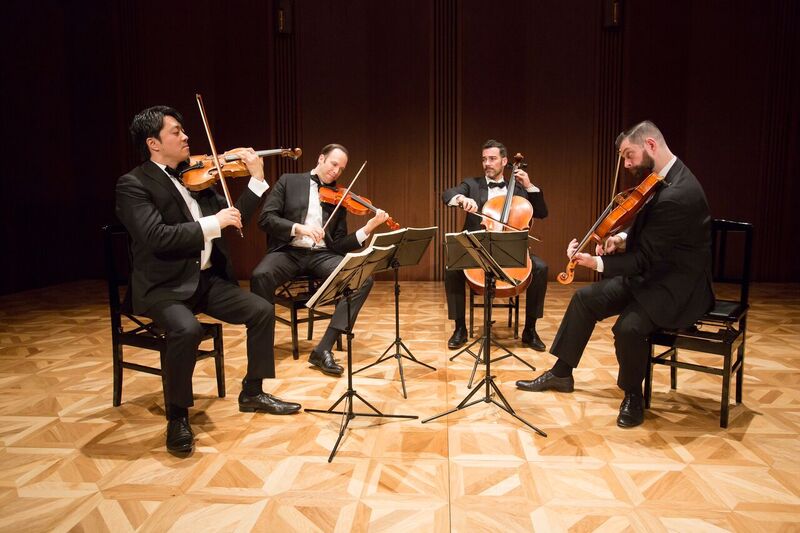Smart Contemporary Chamber Music at La Jolla SummerFest
In his opening remarks to Sunday’s La Jolla SummerFest concert, composer David Lang explained that he chose the evening’s program to demonstrate how certain contemporary composers were showing their respect for music’s past. He gave us a helpful insight to Caroline Shaw’s 2011 work “Entre’acte,” noting that the composer set to work on this piece for string quartet after experiencing a quartet by Joseph Haydn.

Miró Quartet: Daniel Ching, William Fedkenheuer, Joshua Gindele, John Largess. [Photo (c.) Suntory Hall]
For Chris Cerrone’s “South Catalina,” Lang suggested we think of medieval music: a sonorous cantus firmus over which a musical tableau is constructed. Clarinetist Joseph Morris opened “South Catalina” with delicate multiphonics augmented by Dustin Donahue’s delicately bowed single sustained tones from the vibraphone to create Cerrone’s haunting cantus firmus. Soon the other instruments came in like the tolling of bells: thundering bass chords from pianist Timo Andres, piccolo flutters from Rose Lombardo, tingling shards from Donahue’s strokes on the crotales, and delicate shimmers from cellist Hannah Moses and violinist Paul Aguilar. The slowly moving work created an enchanting minimalist sound block, an approach familiar to followers of Arvo Pärt, although without the Estonian composer’s austere remoteness.
A bit of research revealed that Cerrone studied with Lang at Yale and that he wrote “South Catalina” in 2013 while working on the production of his opera Invisible Cities, inventively staged in October of that year in Los Angeles’ Union Station. Cerrone chose the title “South Catalina” from the name of a street in that city’s Koreatown, where he lived while producing Invisible Cities.
For Gabriella Smith’s “Carrot Revolution,” the Miró Quartet returned to the stage of the JAI Theatre. “Carrot Revolution” opened with a torrent of rhythmic scraping by the upper strings, while cellist Joshua Gindele used his instrument for percussive purposes, tapping on the body of the cello with abandon. First violinist Daniel Ching offered Smith’s few grudgingly bowed themes, while violinist William Fedkenheuer and violist John Largess continued their scraping ostinatos and Gindele plucked the cello’s ostinato.
Contemporary string quartet composers may have left the sonata allegro form on the refuse pile of music history, but they cling to the sacred ostinato with the tenacity of lifeboat survivors rowing from a sinking ship. Smith’s 22-minute ostinato etude created a busy stasis that crept to the brink of chaos but did not enter. I could not decide if I was relieved or disappointed.
Like the Biblical story of the wedding at Cana—jugs of water miraculously turned into excellent wine—Lang saved the best for the last, his own chamber cantata “Death Speaks.” He explained that he carefully went through all 600+ songs composed by Franz Schubert to find some 30 references to Death voicing some call or statement to mortals. Why he conducted this research, he did not say, but these quotations—translated into English—became the text of his five-movement, half hour threnody “Death Speaks.”
Most of the time, vocalist Nora Fisher was restricted to a slow, legato incantation, which she communicated with solemn diligence. Timo Andres returned to the piano and, with violinist Tatjana Roos and electric guitarist Derek Johnson, produced a delicately structured cloud of sound that both buoyed Fisher and compromised the finesse of her delivery. Because she was lightly amplified, this was not so much a matter of volume, but Lang’s scoring the accompanying instruments largely in her range. Their overtones masked her overtones and covered her consonants, turning many of her lyrics into a vocalise.
Fortunately, Lang did give his singer some dramatic moments, and Fisher exploited them with command and conviction. I found the fourth movement in which Fisher gently chanted over Johnson’s serenely plucked chaconne eloquently moving.
This concert was presented by the La Jolla Music Society’s SummerFest 2019 in the JAI concert hall at the Conrad Prebys Performing Arts Center in downtown La Jolla on Sunday, August 11, 2019. The festival continues at The Conrad through August 23.

Ken Herman, a classically trained pianist and organist, has covered music for the San Diego Union, the Los Angeles Times’ San Diego Edition, and for sandiego.com. He has won numerous awards, including first place for Live Performance and Opera Reviews in the 2017, the 2018, and the 2019 Excellence in Journalism Awards competition held by the San Diego Press Club. A Chicago native, he came to San Diego to pursue a graduate degree and stayed.Read more…
